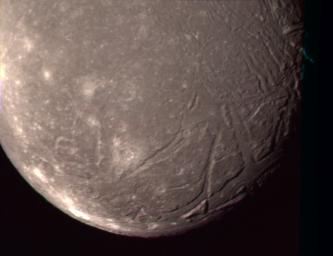
|
Ariel - Highest Resolution Color Picture
- Click the image above for a larger view
- Full-Res JPEG (845 x 650) (45.9 kB)
- Full-Res TIFF (845 x 650) (1.5 MB)
Caption:
The complex terrain of Ariel is viewed in this image, the best Voyager 2 color picture of the Uranian moon. The individual photos used to construct this composite were taken Jan. 24, 1986, from a distance of 170,000 kilometers (105,000 miles. Voyager captured this view of Ariel's southern hemisphere through the green, blue and violet filters of the narrow-angle camera; the resolution is about 3 km (2 mi). Most of the visible surface consists of relatively intensely cratered terrain transected by fault scarps and fault-bounded valleys (graben). Some of the largest valleys, which can be seen near the terminator (at right), are partly filled with younger deposits that are less heavily cratered. Bright spots near the limb and toward the left are chiefly the rims of small craters. Most of the brightly rimmed craters are too small to be resolved here, although one about 30 km (20 mi) in diameter can be easily distinguished near the center. These bright-rim craters, though the youngest features on Ariel, probably have formed over a long span of geological time. Although Ariel has a diameter of only about 1,200 km (750 mi), it has clearly experienced a great deal of geological activity in the past.
Background Info:
The Voyager project is managed for NASA by the Jet Propulsion Laboratory.
Cataloging Keywords:
| Name | Value | Additional Values |
|---|---|---|
| Target | Ariel | |
| System | Uranus | |
| Target Type | Satellite | |
| Mission | Voyager | |
| Instrument Host | Cassini Orbiter | Voyager 2 |
| Host Type | Orbiter | Flyby Spacecraft |
| Instrument | Imaging Science Subsystem (ISS) | |
| Detector | Narrow Angle Camera | |
| Extra Keywords | Color, Crater, Visual | |
| Acquisition Date | ||
| Release Date | 1996-01-29 | |
| Date in Caption | 1986-01-24 | |
| Image Credit | NASA/JPL | |
| Source | photojournal.jpl.nasa.gov/catalog/PIA00041 | |
| Identifier | PIA00041 | |
